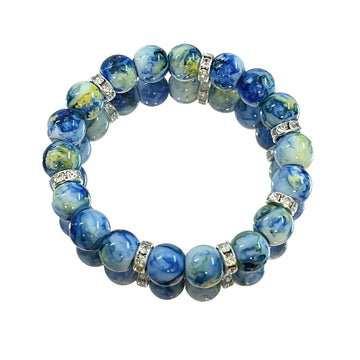Suitable tools and material selection for cleaning stone bracelets
When cleaning stone bracelets, tools and materials should be selected based on the characteristics of the stone, the inlaying technique and the type of stains to avoid damaging the stone or the structure. The following are the specific recommendations:
First, basic cleaning tools
Soft-bristled brush
Recommended: Baby toothbrush (with bristles less than 0.1mm in diameter), horsehair brush or soft-bristled makeup brush.
Function: Gently clean the crevices and carved details to prevent the hard bristle brush from scratching the stone surface.
For example, the carved patterns of jade bracelets should be gently brushed along the texture direction with a soft-bristled brush.
Cleaning cloth
Recommended: Professional jewelry cleaning cloths (such as 3M microfiber cloths), eyeglass cloths or silk.
Function: It has strong water absorption and no particle residue, preventing the scratching of metals or stones.
When wiping metal parts, use a dry and clean cloth to gently wipe in the same direction.
Cotton swab
Recommendation: Medical degreased cotton swabs (unbleached and free of impurities).
Function: Clean metal crevices, the bottom of inlaid gemstones or dead corners of carvings.
For example: Dip a cotton swab in a small amount of detergent and gently rotate it to wipe the inner side of the ring or the clasp of the bracelet.
Second, clean materials
Neutral detergent
Recommended: Baby shampoo (pH 5.5-7.0), mild hand sanitizer or special jewelry cleaners (such as Connoisseurs).
Function: To prevent strong acids and alkalis from corroding stone. For instance, jadeite is prone to losing its luster when exposed to acid, and pearls will dissolve when in contact with acidic cleaning agents.
For example: 1 drop of baby shampoo +100ml of distilled water, stir well and use a soft-bristled brush to dip and clean.
Distilled water
Function: To rinse off residual cleaning agents and prevent chlorine or minerals in tap water from corroding the stone.
After cleaning, soak in distilled water for 1 minute and then dry with a clean cloth.
Natural substitutes
Recommendation: Baking soda + water (1:5 ratio), olive oil (only for wooden bracelets).
Function: Gently removes dirt, suitable for simple daily cleaning.
Apply the baking soda paste to the metal parts, let it stand for 5 minutes, and then scrub it off with a soft-bristled brush.
Third, select tools and materials according to the type of stone
Hard stones (such as diamonds, rubies, sapphires)
Tools: Ultrasonic cleaner (make sure it is firmly embedded), hard-bristled brush (such as horsehair brush).
Materials: Neutral cleaner or special gemstone cleaner.
Taboo: Avoid bleach and chlorine-containing cleaners.
Soft stones (such as pearls, corals, amber)
Tools: Soft cloth, cotton swabs.
Materials: Distilled water, baby talcum powder (for drying).
Taboo: Do not use cleaning agents or ultrasonic cleaning.
Jade (such as jadeite, Hetian jade)
Tools: Soft-bristled brush, silk.
Ingredients: White tea oil (for maintenance), neutral detergent.
Taboo: Avoid high temperatures and collisions with hard objects.
Fourth, special scene tools and materials
Metal inlaid part
Tools: Toothpicks (wrapped in cotton cloth), professional jewelry tweezers.
Materials: Neutral detergent, metal polishing cloth.
Operation: Use a toothpick dipped in detergent to clean the crevices, and wipe the metal surface with a polishing cloth.
Stubborn stains
Tools: Ultrasonic cleaner (when firmly embedded), professional cleaning brush.
Materials: Specialized cleaners (such as Weiman jewelry cleaner).
Ultrasonic clean for 1-2 minutes, then gently brush the details with a soft-bristled brush.
Fifth, forbidden tools and materials
Youdaoplaceholder0 Hard tools: metal tweezers, wire brush (may scratch stone or metal).
Youdaoplaceholder0 Chemical cleaners: Bleach, 84 disinfectant (corrode stone surfaces).
Youdaoplaceholder0 Hot tools: Hair dryer hot setting (may cause stone to crack or metal to deform).
Sixth, maintain the materials after cleaning
Drying tools: lint-free cloth, kitchen paper towels (press to absorb water).
Care oils: White tea oil (jade), baby oil (pearl).
Storage box: Independent jewelry box (scratch-resistant), desiccant (moisture-proof).
Summary: When cleaning stone bracelets, it is necessary to "tailor measures to the specific material". For hard stones, ultrasonic cleaning can be appropriately used, while for soft stones, chemical contact should be avoided throughout the process. Drying immediately after cleaning and regular maintenance can extend the service life of the bracelet. If you have any doubts about the cleaning method, it is recommended that you give priority to the service of a professional jewelry store.







